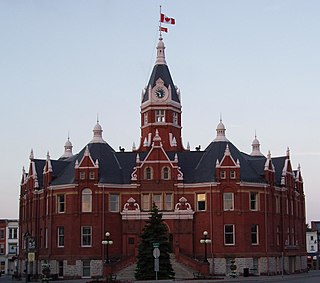
Stratford is a city on the Avon River within Perth County in southwestern Ontario, Canada, with a 2021 population of 33,232 in a land area of 30.02 square kilometres (11.59 sq mi). Stratford is the seat of Perth County, which was settled by English, Irish, Scottish and German immigrants, in almost equal numbers, starting in the 1820s but primarily in the 1830s and 1840s. Most became farmers; even today, the area around Stratford is known for mixed farming, dairying and hog production.

The Stratford Festival is a theatre festival which runs from April to October in the city of Stratford, Ontario, Canada. Founded by local journalist Tom Patterson in 1952, the festival was formerly known as the Stratford Shakespearean Festival, the Shakespeare Festival and the Stratford Shakespeare Festival. The festival was one of the first arts festivals in Canada and continues to be one of its most prominent. It is recognized worldwide for its productions of Shakespearean plays.
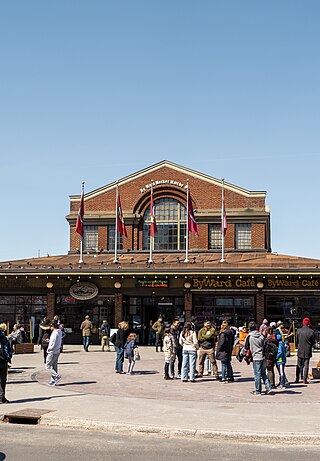
The ByWard Market, is a retail and entertainment district in the downtown core of Ottawa, Ontario, Canada. It is located east of the government and business district. The Market district includes the market buildings and open-air market along George, York, ByWard, and William street.

The Camden markets are a number of adjoining large retail markets, often collectively referred to as Camden Market or Camden Lock, located in the historic former Pickfords stables, in Camden Town, London. It is situated north of the Hampstead Road Lock of the Regent's Canal. Famed for their cosmopolitan image, products sold on the stalls include crafts, clothing, books, bric-a-brac, and fast food. It is the fourth-most popular visitor attraction in London, attracting approximately 250,000 people each week.

St. Lawrence Hall is a meeting hall in Toronto, Ontario, Canada, located at the corner of King Street East and Jarvis Street. It was created to be Toronto's public meeting hall home to public gatherings, concerts, and exhibitions. Its main feature was a thousand-seat amphitheatre. For decades the hall was the centre of Toronto's social life before larger venues took over much of this business. Today the hall continues as a venue for events including weddings, conferences, and art shows.

The Rex is a cinema in the town of Berkhamsted, Hertfordshire, England. Designed in the art deco style by David Evelyn Nye in 1936, the cinema opened to the public in 1938. After 50 years of service, the cinema closed in 1988 and became derelict. The building was listed Grade II by English Heritage, and following a campaign to save the Rex by a local entrepreneur, the cinema re-opened to the public in 2004.
Raffi Armenian, is a Canadian conductor, pianist, composer, and teacher. He directed the Kitchener–Waterloo Symphony orchestra for many years. Since 1999 he has been the director of Orchestral Studies at the University of Toronto. From 2008 to 2013 he was the director of the Conservatoire de musique du Québec à Montréal.

Kirkgate Market is a market complex on Vicar Lane in the city centre of Leeds, West Yorkshire, England. It is the largest covered market in Europe and a Grade I listed building. There are currently 800 stalls which attract over 100,000 visitors a week.
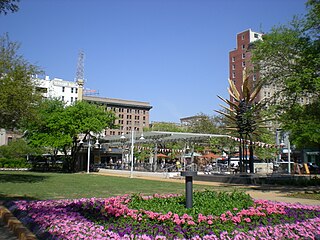
Market Square Park is a public park in Downtown Houston, Texas, United States. Originally set aside by the Houston Town Company as "Congress Square," the public square was used as a marketplace and city hall, which assumed the name, "Market Square." The City of Houston constructed four different market house/city halls, the first of which opened in 1840. The fourth was constructed in 1904. Market Square is a central feature of the Main Street/Market Square Historic District, a historic district listed on the National Register of Historic Places. The square is surrounded by a combination of nineteenth-century architecture and modern residential towers, with ground leases housing a variety of restaurants and bars.

Egmondville is an unincorporated rural community in Huron East, Huron County, Ontario, Canada.
St. Andrew's Playground is a small park in downtown Toronto. It is located at the 450 Adelaide Street West, at the northwest corner of Brant St and Adelaide. It has a playground for children and an off-leash area for dogs that is surrounded by a short fence, with an accessible water fountain for pets, children, and adults. A Heritage Toronto plaque in the northwest corner describing the history and significance of the park was installed in 2007.

St. Lawrence Market is a major public market in Toronto, Ontario, Canada. It is located along Front Street East and Jarvis Street in the St. Lawrence neighbourhood of downtown Toronto. The public market is made up of two sites adjacent to one another west of Jarvis Street, St. Lawrence Market North, and St. Lawrence Market South. St. Lawrence Market South is situated south of Front Street East, and is bounded by The Esplanade to the south. St. Lawrence Market North is situated north of Front Street East, and is bounded by St. Lawrence Hall to the north.

Kingston City Hall is the seat of local government in Kingston, Ontario, Canada. Occupying a full city block facing Lake Ontario in Kingston's downtown, the city hall is a prominent building constructed in the Neoclassical style with a landmark tholobate and dome.

Bolton Market Hall is a listed building in Bolton, Greater Manchester that is now the Market Place Shopping Centre. The market hall and its integral ground-floor shops on Bridge Street, Corporation Street and Knowsley Street are included in the English Heritage listing.
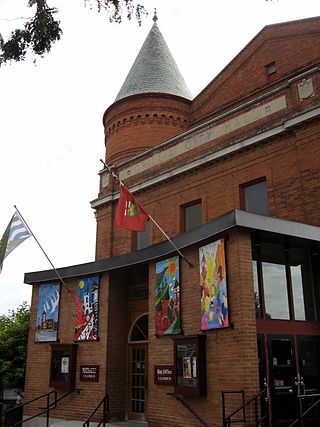
The Orillia Opera House is a historic building in the city of Orillia, Ontario, Canada. It has been listed as a historic property under the Ontario Heritage Act.
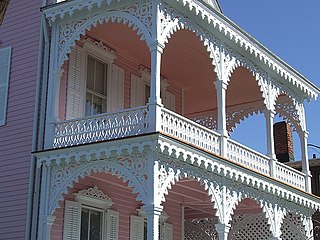
Gingerbread is an architectural style that consists of elaborately detailed embellishment known as gingerbread trim. It is more specifically used to describe the detailed decorative work of American designers in the late 1860s and 1870s, which was associated mostly to the Carpenter Gothic style. It was loosely based on the Picturesque period of English architecture in the 1830s.
The Stratford General Strike of 1933 was a strike by 650 furniture workers and 100 chicken-pluckers in Stratford, Ontario, Canada. The strikes were led by workers from recently unionized factories in the Stratford area with the purpose of securing higher wages. It also represented the final time the Canadian military was called to assist in quelling a strike.

Doncaster Market lies in the centre of the city of Doncaster, in South Yorkshire, England.
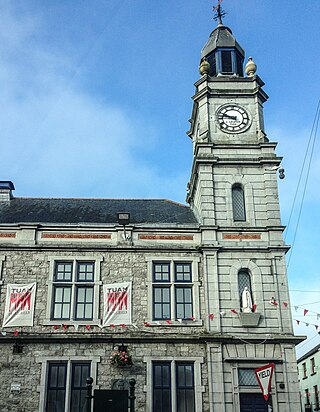
Tuam Town Hall is a municipal building in the Market Square at Tuam, County Galway, Ireland. It is currently used as a community events venue.

Pontypridd Market and Town Hall is a historic building located on Market Street, Pontypridd in Rhondda Cynon Taf in Wales. The structure, which contains a large auditorium which is currently derelict, was built in two parts both of which are Grade II listed buildings.



















